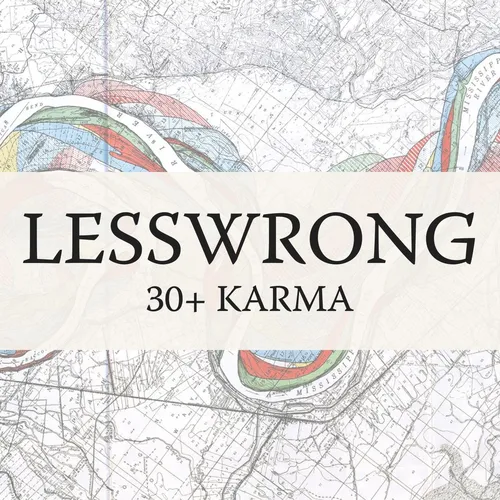
LessWrong (30+ Karma)
Audio narrations of LessWrong posts.
- Update frequency
- every day
- Average duration
- 18 minutes
- Episodes
- 583
- Years Active
- 2025

“Melatonin Self-Experiment Results” by silentbob
Throughout the first half of 2025 I did a blinded experiment to see how low to moderate melatonin intake affects me. In this post I summarize my findings.
Tl;dr: In my blinded self-experiment on mel…
![[Linkpost] “New Paper: Ambiguous Online Learning” by Vanessa Kosoy](https://b2.eachpod.com/podcast-imgs/19ecf0b0e5260863b6ed64b96f5e6449.webp)
[Linkpost] “New Paper: Ambiguous Online Learning” by Vanessa Kosoy
Abstract: We propose a new variant of online learning that we call "ambiguous online learning". In this setting, the learner is allowed to produce multiple predicted labels. Such…

“What does 10x-ing effective compute get you?” by ryan_greenblatt
This is more speculative and confusing than my typical posts and I also think the content of this post could be substantially improved with more effort. But it's been sitting around in my drafts for…

“A regime-change power-vacuum conjecture about group belief” by TsviBT
Crosspost from my blog.
Regime change
Conjecture: when there is regime change, the default outcome is for a faction to take over—whichever faction is best prepared to seize power by force.
One ex…

“Analyzing A Critique Of The AI 2027 Timeline Forecasts” by Zvi
There was what everyone agrees was a high quality critique of the timelines component of AI 2027, by the LessWrong user and Substack writer Titotal.
It is great to have thoughtful critiques like th…

“Why ‘training against scheming’ is hard” by Marius Hobbhahn
TLDR: I think that AI developers will and should attempt to reduce scheming by explicitly training the model to scheme less. However, I think “training against scheming” is a harder problem than oth…

“My pitch for the AI Village” by Daniel Kokotajlo
I think the AI Village should be funded much more than it currently is; I’d wildly guess that the AI safety ecosystem should be funding it to the tune of $4M/year.[1] I have decided to donate $100k. …

“Situational Awareness: A One-Year Retrospective” by Nathan Delisle
Nathan Delisle, University of Chicago
tl;dr: Many critiques of *Situational Awareness* have been purely qualitative; one year later we can finally check the numbers. I did my best to verify his clai…

“Compressed Computation is (probably) not Computation in Superposition” by Jai Bhagat, Sara Molas Medina, Giorgi Giglemiani, StefanHex
Audio note: this article contains 113 uses of latex notation, so the narration may be difficult to follow. There's a link to the original text in the episode description.
This research was complet…

“‘It isn’t magic’” by Ben (Berlin)
People keep saying "AI isn't magic, it's just maths" like this is some kind of gotcha.
Turning lead into gold isn't the magic of alchemy, it's just nucleosynthesis.
Taking a living human's heart out…

“Foom & Doom 1: ‘Brain in a box in a basement’” by Steven Byrnes
1.1 Series summary and Table of Contents
This is a two-post series on AI “foom” (this post) and “doom” (next post).
A decade or two ago, it was pretty common to discuss “foom & doom” scenarios, as ad…

“Foom & Doom 2: Technical alignment is hard” by Steven Byrnes
2.1 Summary & Table of contents
This is the second of a two-post series on foom (previous post) and doom (this post).
The last post talked about how I expect future AI to be different from present AI…

“Comparing risk from internally-deployed AI to insider and outsider threats from humans” by Buck
I’ve been thinking a lot recently about the relationship between AI control and traditional computer security. Here's one point that I think is important.
My understanding is that there's a big qual…

“Clarifying ‘wisdom’: Foundational topics for aligned AIs to prioritize before irreversible decisions” by Anthony DiGiovanni
As many folks in AI safety have observed, even if well-intentioned actors succeed at intent-aligning highly capable AIs, they’ll still face some high-stakes challenges.[1] Some of these challenges ar…

“Racial Dating Preferences and Sexual Racism” by koreindian
Note: This is a linkpost from my personal substack. This is on a culture war topic, which is not normally the focus of my blogging. Rationalist friends suggested that this post might be interesting …

“The Sixteen Kinds of Intimacy” by Ruby
John Wentworth recently posted a discussion-inducing piece about how the willingness to be vulnerable is core to romantic relationships. This is not obvious to me as the core thing. I think romantic…

“Consider chilling out in 2028” by Valentine
I'll explain my reasoning in a second, but I'll start with the conclusion:
I think it'd be healthy and good to pause and seriously reconsider the focus on doom if we get to 2028 and the situation fe…

“the sillk pajamas effect” by thiccythot
<div> <img src="https://substackcdn.com/image/fetch/w_1456,c_limit,f_webp,q_auto:good,fl_progressive:steep/https%3A%2F%2Fsubstack-post-media.s3.amazonaws.com%2Fpublic%2Fimages%2Fd0ea456c-7425-47d9-b…

“Genomic emancipation” by TsviBT
PDF version. berkeleygenomics.org. x.com. bluesky. YouTube.
Introduction
We, the free world, as a society, should decide to invest in the development of technology for human germline genomic engin…

“Making deals with early schemers” by Julian Stastny, Olli Järviniemi, Buck
Consider the following vignette:
It is March 2028. With their new CoCo-Q neuralese reasoning model, a frontier AI lab has managed to fully automate the process of software engineering. In AI R&D, mo…